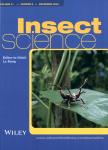Comparison of fatty acid composition in total lipid of diapause and non-diapause larvae of Cydia pomonella (Lepidoptera: Tortricidae)
Comparison of fatty acid composition in total lipid of diapause and non-diapause larvae of Cydia pomonella (Lepidoptera: Tortricidae)作者机构:Department of Entomology College of Agriculture Tarbiat Modares UniversityTarbiat Modares University Tehran Iran Department of Food Science and Technology College of Agriculture Tarbiat Modares University Tarbiat Modares University Tehran Iran Department of Biophysics College of Basic Sciences Tarbiat Modares University Tehran Iran
出 版 物:《Insect Science》 (昆虫科学(英文版))
年 卷 期:2007年第14卷第2期
页 面:125-131页
核心收录:
学科分类:09[农学] 0904[农学-植物保护] 090401[农学-植物病理学] 090402[农学-农业昆虫与害虫防治]
主 题:codling moth Cydia pomonella diapause fatty acid composition lipid
摘 要:Seasonal changes in the fatty acid composition of the total lipid extracted from the whole body of Cydia pomonella L. larvae were determined by gas chromatography. The six most abundant fatty acids in both non-diapause and diapause larvae of codling moth were oleic (35%-39%), palmitic (23%-33%), linoleic (16%-30%), palmitoleic (5%-10%), stearic (1.5%-3.0%) and linolenic acids (1.0%-2.5%). This represents a typical complement of Lepidopteran fatty acids. The fatty acid composition of total lipid of C. pomonella larvae was related to diapause. In similarity to most other reports, the proportion of unsaturated fatty acids increased in diapause initiation state. The total lipid of diapause larvae contained more linoleic acid (25.8% vs. 16.1%) and less palmitic acid (24.7% vs. 33.4%), than that of non-diapause larvae. The weight percentage of linoleic acid (C 18:2) increased from 16% to 26% from early-August through early-September during transition to diapause, while palmitic acid (C16:0) decreased from 33% to 25% at the same time. These changes resulted in an increase in the ratio of unsaturated to saturated fatty acids (UFA/SFA) from 1.72 in non-diapause larvae to 2.63 in diapause larvae.



